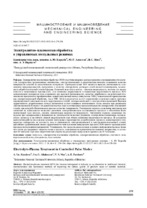| dc.contributor.author | Королёв, А. Ю. | |
| dc.contributor.author | Алексеев, Ю. Г. | |
| dc.contributor.author | Нисс, В. С. | |
| dc.contributor.author | Паршуто, А. Э. | |
| dc.coverage.spatial | Минск | ru |
| dc.date.accessioned | 2021-07-15T13:36:04Z | |
| dc.date.available | 2021-07-15T13:36:04Z | |
| dc.date.issued | 2021 | |
| dc.identifier.citation | Электролитно-плазменная обработка в управляемых импульсных режимах = Electrolyte-Plasma Treatment in Controlled Pulse Modes / А. Ю. Королёв [и др.] // Наука и техника. – 2021. – № 4. – С. 279-286. | ru |
| dc.identifier.uri | https://rep.bntu.by/handle/data/97419 | |
| dc.description.abstract | Электролитно-плазменная обработка (ЭПО) получила широкое распространение в промышленности в качестве альтернативы традиционным химическим, электрохимическим и механическим методам повышения качества поверхности изделий из металлических материалов. Преимуществами ЭПО являются высокая интенсивность сглаживания микронеровностей, применение в качестве электролитов растворов солей низкой концентрации, возможность обработки изделий сложной формы. Основной недостаток метода – высокая энергоемкость, поэтому его можно отнести к энергоемкому производству. Для снижения энергоемкости и повышения эффективности процесса ЭПО металлических материалов при сохранении его высокой интенсивности, качества обработки и экологической безопасности предлагается принципиально новый импульсный метод (импульсная ЭПО), совмещающий преимущества как электрохимической обработки, так и ЭПО. Метод реализуется за счет совмещения в пределах одного импульса миллисекундной длительности двух чередующихся стадий: электрохимической и электролитно-плазменной. Высокая эффективность разработанного метода достигается за счет основного интенсивного съема металла при реализации электрохимической стадии с большой плотностью тока и оптимизации продолжительности электролитно-плазменной стадии, при которой обеспечивается высокое качество поверхности. Уменьшение периода следования импульсов при снижении их длительности позволяет увеличить электрохимическую составляющую процесса и обеспечить более интенсивный съем металла, удалить значительные неровности поверхности. Увеличение периода следования импульсов при одновременном повышении их длительности позволяет увеличить электролитно-плазменную составляющую процесса и достигнуть низкой шероховатости при общем снижении энергоемкости процесса. В результате выполнения работы исследовано влияние импульсных характеристик разработанного процесса, концентрации и температуры электролита на плотность тока и длительность электрохимической и электролитно-плазменной стадий, произведен сравнительный анализ эффективности использования импульсного процесса ЭПО вместо традиционного процесса на постоянном напряжении. Установлено, что скорость съема металла в данном импульсном процессе более чем в пять раз превышает скорость съема в процессе, основанном на применении постоянного напряжения, и составляет 40 мкм/мин. При этом энергетические затраты на реализацию импульсного процесса на 19 % меньше. | ru |
| dc.language.iso | ru | ru |
| dc.publisher | БНТУ | ru |
| dc.title | Электролитно-плазменная обработка в управляемых импульсных режимах | ru |
| dc.title.alternative | Electrolyte-Plasma Treatment in Controlled Pulse Modes | ru |
| dc.type | Article | ru |
| dc.identifier.doi | 10.21122/2227-1031-2021-20-4-279-286 | |
| local.description.annotation | Electrolyte-plasma treatment (EPT) has become widespread in industry as an alternative to traditional chemical, electrochemical and mechanical methods of improving the surface quality of products made of metallic materials. The advantages of EPT are a high intensity of smoothing of microroughnesses, the use of low-concentration salt solutions as electrolytes, and the ability to process items of complex shape. The main disadvantage of the method is its high energy consumption; therefore, the method сan be classified as energy-intensive production. To reduce the energy intensity and increase the efficiency of the EPT process of metallic materials while maintaining high intensity, processing quality and environmental safety, we proposed a fundamentally new pulse method (pulsed EPT), which combines the advantages of both electrochemical processing and EPT. The method is realized by combining two alternating stages within one millisecond pulse: electrochemical and electrolyte-plasma. The high efficiency of the developed method is achieved due to the main intensive metal removal during the implementation of the electrochemical stage with a high current density and optimization of the duration of the electrolyte-plasma stage, which provides a high surface quality. A decrease in the repetition period of pulses with a decrease in their duration makes it possible to increase the electrochemical component of the process and to provide a more intensive metal removal, to remove significant surface irregularities. An increase in the pulse repetition period with a simultaneous increase in their duration permits to increase the electrolyte-plasma component of the process and achieve a low roughness with a general decrease in the energy intensity of the process. As a result of the work, the influence of the pulse characteristics of the developed process, the concentration and temperature of the electrolyte on the current density and the duration of the electrochemical and electrolyte-plasma stages has been investigated, a comparative analysis of the efficiency of using the pulsed EPT process instead of the traditional process at constant voltage has been carried out. It has been found that the metal removal rate in the developed pulse process is more than five times higher than the removal rate in the process based on the use of constant voltage, and is 40 μm/min, while the energy costs for the implementation of the pulse process is 19 % less. | ru |

